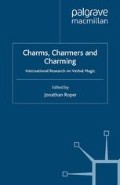Abstract
The order of reptiles contains about 2,500 species of snakes. Due to biological and physical variation, popular interpretations of the qualities of snakes differ greatly between cultures. But generally facets emerge, due to its appearance, way of motion and (supposed) dangerousness, the snake has frequently been seen as an anomalous, and often also mythical, animal. Due to this a rich snake-lore exists. Despite contradictory elements in oral traditions worldwide, it would be foolhardy to assume that the variety found in the interpretations of and attitudes taken towards snakes is solely due to its multiplicity of species. The differences between local species have been both recognised and disregarded by people in illiterate cultures.
Access this chapter
Tax calculation will be finalised at checkout
Purchases are for personal use only
Preview
Unable to display preview. Download preview PDF.
Bibliography
SKVR=Suomen Kansan Vanhat Runot, e.g. Niemi (1931) and Salminen (1924).
Arukask, Madis ‘Religious Syncretism in Setu Runo Songs’, Studies in Folklore and Popular Religion 2 (1999), 79–92.
Clodd, Edward, Magic in Names and in Other Things. London: Chapman and Hall, 1920.
Gimbutas, Marija, The Language of the Goddess, Unearthing the Hidden Symbols of Western Civilisation. San Francisco: Harper Row, 1989.
Goode, William J., ‘Magic and religion. A continuum’, Ethnos 14 (1949), 172–82.
Hautala, Jouko, ‘Sanan mahti’ in Jumin keko. Tutkielmia kansanrunoustieteen alalta.Helsinki: Suomalaisen Kirjallisuuden Seura, 1960, 7–42. (Tietolipas, 17).
Hill, Donald R., ‘Magic in primitive societies’ in The Encyclopedia ofReligion. Vol. 9. New York & London: Macmillan, 1987.
Honko, Lauri, Timonen, Senni & Branch, Michael, The Great Bear. A Thematic Anthology of Oral Poetry in the Finno-Ugrian Languages. Helsinki: Suomalaisen Kirjallisuuden Seura, 1993.
Hästesko, F. A., Länsisuomalainen loitsurunous. Helsinki: Suomalaisen Kirjallisuuden Seura, 1918. (SKS toimituksia, 161).
Kuusi, Matti, ‘Keskiajan kalevalainen runous’ in Suomen kirjallisuus 1. Helsinki: Otava, 1963, pp. 273–397.
Loorits, Oskar, Grundzüge des estnischen Volksglaubens 1. Uppsala: 1949. (Skrifter utgivna av Kungliga Gustav Adolfs Akademien, 18: 1 )
Luven, Yvonne, Der Kult der Hausschlange. Ein Studie zur Religionsgeschichte der Letten und Litauer. Köln, Weimar & Wien: Böhlau Verlag, 2001. (Quellen und Studien zur Baltischen Geschchte, 17).
Niemi, A.R. ed., Suomen Kansan Vanhat Runot VII: 3: Raja- ja Pohjois-Karjalan runot 3. Lyyrillisiä. Toisinnot 3812–4627. Loitsuja. Toisinnot 1–1549. Helsinki: Suomalaisen Kirjallisuuden Seura, 1931.
Pentikäinen, Juha, Marina Takalon uskonto. Uskontoantropologinen tutkimus. Helsinki: Suomalaisen Kirjallisuuden Seura, 1971.
Pyysiäinen, Ilkka, Magic, Miracles and Religion. A Scientist’s Perspective. Walnut Creek: Altamira Press, 2004.
Salminen, V., ed., SuomenKansan VanhatRunotIII: 3: Länsi-Inkerin runot3. Toisinnot 2581–4634. Helsinki: Suomalaisen Kirjallisuuden Seura, 1924.
Stark-Arola, Laura, ‘Christianity and wilderness: Syncretism in Orthodox Karelian magic as culture-specific strategies’, Studies in folklore and popular religion 2 (1999), 93–120.
Wedeck, Harry E., A Treasury of Witchcraft. London: Vision, 1961.
Wilson, Stephen, The Magical Universe: Everyday Ritual and Magic in Pre-Modern Europe. London: Hambledon and London, 2000.
Wolf-Knuts, Ulrika, ‘The Virgin Mary in Ostrobothnian Magic Spells’, Studies in Folklore and Popular Religion 2 (1999), 65–78.
Editor information
Editors and Affiliations
Copyright information
© 2009 Henni Ilomäki
About this chapter
Cite this chapter
Ilomäki, H. (2009). Finnish Snake Charms. In: Roper, J. (eds) Charms, Charmers and Charming. Palgrave Historical Studies in Witchcraft and Magic. Palgrave Macmillan, London. https://doi.org/10.1057/9780230583535_12
Download citation
DOI: https://doi.org/10.1057/9780230583535_12
Publisher Name: Palgrave Macmillan, London
Print ISBN: 978-1-349-36250-9
Online ISBN: 978-0-230-58353-5
eBook Packages: Palgrave History CollectionHistory (R0)

